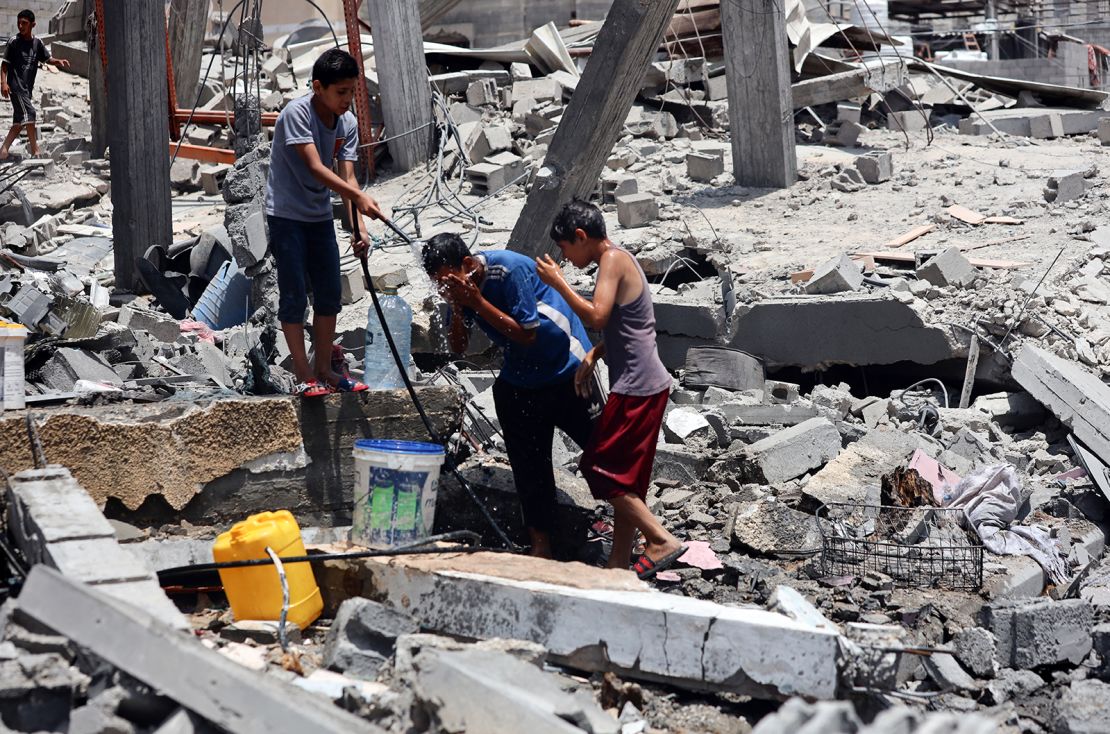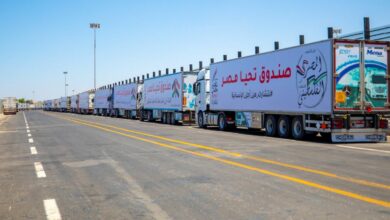
Guns swinging from their hips, two soldiers in black combat boots and green tactical clothing appear to wire explosives to pumps at the Canada Water reservoir in Rafah, southern Gaza.
Moments later, an orange blaze tears through the critical facility in the Tal al-Sultan neighborhood, as ribbons of grey smoke erupt into the sky.
The blast was captured in a now deleted video, which was reportedly shared by an Israeli soldier on Instagram and geolocated by CNN. Satellite imagery shows that the reservoir was damaged between July 26 and July 27. Destroyed buildings are visible in the surrounding area.
The reservoir could hold 3 million liters of water and was central to the treatment and distribution of water in the Rafah Governate, according to the UN’s Office for the Coordination of Humanitarian Affairs (OCHA), providing water for 150,000 people prior to October 7, when the war began.
When asked about the incident captured on camera, the Israel Defense Forces (IDF) told CNN that its troops had been operating in the Tal al-Sultan area for several weeks to “dismantle terrorist infrastructures and eliminate terrorists, whilst taking feasible measures in order to mitigate damage to civilian structures.”
It added that it examines reports of videos posted to social media and handles them with disciplinary measures. The IDF said the incident was under review by the Fact Finding and Assessment Mechanism, “an independent investigative mechanism outside the chain of command entrusted with investigating exceptional events in warfare.”
There have been many water facilities damaged or destroyed by Israel’s 10-month-long assault in Gaza, according to the UN and various other international bodies, compounding the civilian population’s suffering, risking the spread of disease and leading human rights experts to accuse Israel of using water supply as a weapon.
The destruction of the Canada Water reservoir “is certainly a breach of international humanitarian law (IHL),” Mark Zeitoun, director general of the Geneva Water Hub, a Swiss institute specializing in hydro-diplomacy, told CNN.
“IHL is meant to protect against indiscriminate attacks on the civilian population or the objects they depend upon (for) survival,” he said.
Even before the controlled explosion in late July, the Israeli siege drained fuel and electricity supplies needed to power the Canada Water reservoir and other water systems in the city, according to Rafah’s mayor, Ahmed Al-Sofi, causing severe shortages.
“Rafah was already suffering from water shortages,” Al-Sofi told CNN in July. “The city of Rafah is a city struck by destruction, hunger and thirst.”
The amount of water available in Gaza works out at 4.74 liters of water (1 gallon) per person per day, Oxfam reported in July, adding that this is “just under a third of the recommended minimum in emergencies and less than a single toilet flush.” The international nonprofit has accused Israel of using water as a “weapon of war,” saying Palestinians in Gaza have “almost no water to drink, let alone to bathe, cook, or clean.”
Extreme summer heat in Gaza is making a desperate shortage of water even worse for Palestinians already stalked by famine and struggling with repeated displacement.
This June was the hottest on record in Israel, according to the Israel Meteorological Service. Temperatures in Negba, a few miles north of Gaza, reached 39.4 C (103F) in the middle of the month, according to CNN meteorologists.
Israel’s war in Gaza has reduced supplies of fuel, chlorine and spare parts, stifling water production, purification and sewage pumping, according to the UN. Around 70% of all water and sanitation facilities in Gaza have been destroyed or damaged, the WASH Cluster, a United Nations-led group that coordinates humanitarian efforts for water, sanitation and hygiene, said on July 24, citing satellite analysis from the UN Satellite Centre.

COGAT, the Israeli agency responsible for approving aid into Gaza, told CNN in a statement that Israel allows and facilitates the “unlimited entry” of water tanks and fuel supplies into Gaza. It added that there has been a “continual effort” since the start of the war to facilitate the repair and extension of water wells, desalination facilities and water mains.
But several Palestinians told CNN they are forced to make hazardous journeys in search of water, risking exposure to Israeli attacks. Two people told CNN they had witnessed physical violence and even killing at public distribution points as people fight for scant resources. Those displaced to makeshift camps described scenes of sewage spilling into the streets and children drinking from puddles.
More than 1.7 million cases of infectious diseases have been recorded in Gaza, according to the Ministry of Health there. Traces of the highly infectious polio virus – transmitted through faeces, and contaminated water or food – were found in a 10-month-old child in the central Gazan city of Deir al-Balah earlier this month. The child was later paralyzed due to the disease, the UN said on August 23.
World Health Organization (WHO) testing discovered the virus in sewage samples in Gaza in July, putting thousands of Palestinians at risk of contracting a disease that can cause paralysis.
After the Gaza Ministry of Health declared a polio epidemic last month, the WHO warned that ongoing Israeli bombardment had stifled vaccination efforts in Gaza. They are now calling for a halt to the fighting to allow for an effective vaccination drive.
Widower Alaa Riyad says he treks many miles every day under the glare of the sun to collect water for his family, in Beit Lahia, northern Gaza.
The 42-year-old told CNN that he became “father and mother” to his children after his wife and 18 other relatives were killed by Israeli bombardment several months ago.
“We have found worms in the water more than once,” he told CNN. “What can we do?… There is no life for us.”
Israeli attacks in the strip have killed more than 40,200 Palestinians and injured about 93,000 since the war started, according to the Ministry of Health in Gaza. The Israeli military launched its aerial and ground assault in Gaza after the militant group Hamas attacked southern Israel on October 7, killing around 1,200 people and abducting more than 250, according to Israeli authorities.
‘Near complete destruction of all water infrastructure’
Gaza’s water crisis has been building for decades. In 2017, the UN’s children’s agency, UNICEF, said that 95% of water from Gaza’s sole aquifer was “unfit for human consumption,” due to over-extraction, seawater infiltration and sewage contamination.
In 2021, about 90% of Gaza’s water came from groundwater wells drawing water from that aquifer, according to the Palestinian Water Authority. The remaining 10% came mostly from desalination plants and Israel’s national water company, Mekorot, via three pipelines.
But since early summer, Gaza’s municipal wells and desalination plants (two out of three of which are functioning) have operated at an average of around 15% and 22% capacity, respectively, according to CNN analysis of WASH Cluster data.
Destroyed and damaged water systems in Gaza amid summer heat
The Israeli military campaign in Gaza has damaged key water infrastructure in the territory, with many Palestinians relying on groundwater wells that fall far short of needs due to fuel shortages. Severe lack of access to clean water and sanitation has led to a surge in health issues, including more than half a million cases of diarrheal illnesses and rising skin infections especially among children, the United Nations reported.






